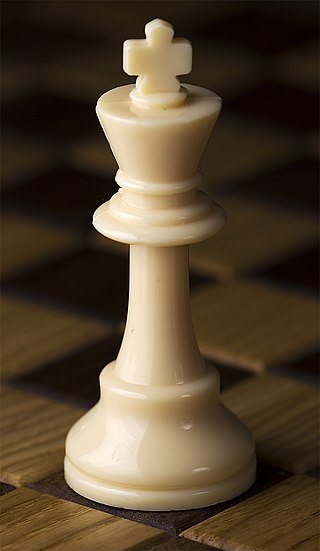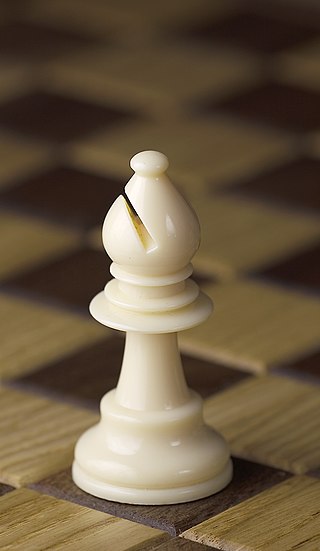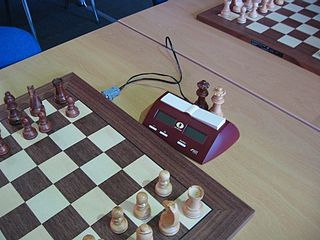Chess strategy is the aspect of chess play concerned with evaluation of chess positions and setting goals and long-term plans for future play. While evaluating a position strategically, a player must take into account such factors as the relative value of the pieces on the board, pawn structure, king safety, position of pieces, and control of key squares and groups of squares. Chess strategy is distinguished from chess tactics, which is the aspect of play concerned with the move-by-move setting up of threats and defenses. Some authors distinguish static strategic imbalances, which tend to persist for many moves, from dynamic imbalances, which are temporary. This distinction affects the immediacy with which a sought-after plan should take effect. Until players reach the skill level of "master", chess tactics tend to ultimately decide the outcomes of games more often than strategy. Many chess coaches thus emphasize the study of tactics as the most efficient way to improve one's results in serious chess play.

The king is the most important piece in the game of chess; the object of the game is to capture the king by checkmate, and the loss of the king entails loss of the game. It may move to any adjoining square; it may also perform, in tandem with the rook, a special move called castling. If a player's king is threatened with capture, it is said to be in check, and the player must remove the threat of capture immediately. If this cannot be done, the king is said to be in checkmate, resulting in a loss for that player. A player cannot make any move that places their own king in check. Despite this, the king can become a strong offensive piece in the endgame or, rarely, the middlegame.

The queen is the most powerful piece in the game of chess. It can move any number of squares vertically, horizontally or diagonally, combining the powers of the rook and bishop. Each player starts the game with one queen, placed in the middle of the first rank next to the king. Because the queen is the strongest piece, a pawn is promoted to a queen in the vast majority of cases.

The bishop is a piece in the game of chess. It moves and captures along diagonals without jumping over intervening pieces. Each player begins the game with two bishops. The starting squares are c1 and f1 for White's bishops, and c8 and f8 for Black's bishops.

A chess piece, or chessman, is a game piece that is placed on a chessboard to play the game of chess. It can be either white or black, and it can be one of six types: king, queen, rook, bishop, knight, or pawn.

The pawn is the most numerous and weakest piece in the game of chess. It may move one square directly forward, it may move two squares directly forward on its first move, and it may capture one square diagonally forward. Each player begins a game with eight pawns, one on each square of their second rank. The white pawns start on a2 through h2; the black pawns start on a7 through h7.
In chess, a pin is a tactic in which a defending piece cannot move out of an attacking piece's line of attack without exposing a more valuable defending piece. Moving the attacking piece to effect the pin is called pinning; the defending piece restricted by the pin is described as pinned. Only a piece that can move any number of squares along a horizontal, vertical, or diagonal line can pin. Any piece can be pinned except the king. The pin is one of the most powerful chess tactics.
This glossary of chess explains commonly used terms in chess, in alphabetical order. Some of these terms have their own pages, like fork and pin. For a list of unorthodox chess pieces, see Fairy chess piece; for a list of terms specific to chess problems, see Glossary of chess problems; for a list of named opening lines, see List of chess openings; for a list of chess-related games, see List of chess variants; for a list of terms general to board games, see Glossary of board games.
A fairy chess piece, variant chess piece, unorthodox chess piece, or heterodox chess piece is a chess piece not used in conventional chess but incorporated into certain chess variants and some chess problems. Compared to conventional pieces, fairy pieces vary mostly in the way they move, but they may also follow special rules for capturing, promotions, etc. Because of the distributed and uncoordinated nature of unorthodox chess development, the same piece can have different names, and different pieces can have the same name in various contexts as it can be noted in the list of fairy chess pieces.
This glossary of chess problems explains commonly used terms in chess problems, in alphabetical order. For a list of unorthodox pieces used in chess problems, see Fairy chess piece; for a list of terms used in chess is general, see Glossary of chess; for a list of chess-related games, see List of chess variants.
In chess, a tactic is a sequence of moves that each makes one or more immediate threats – a check, a material threat, a checkmating sequence threat, or the threat of another tactic – that culminates in the opponent's being unable to respond to all of the threats without making some kind of concession. Most often, the immediate benefit takes the form of a material advantage or mating attack; however, some tactics are used for defensive purposes and can salvage material that would otherwise be lost, or to induce stalemate in an otherwise lost position.
The Trompowsky Attack is a chess opening that begins with the moves:

In chess, promotion is the replacement of a pawn with a new piece when the pawn is moved to its last rank. The player replaces the pawn immediately with a queen, rook, bishop, or knight of the same color. The new piece does not have to be a previously captured piece. Promotion is mandatory when moving to the last rank; the pawn cannot remain as a pawn.

Chu shogi is a strategy board game native to Japan. It is similar to modern shogi in its rules and gameplay. Its name means "mid-sized shogi", from a time when there were three sizes of shogi variants that were regularly being played. Chu shogi seems to have been developed in the early 14th century as a derivative of dai shogi. There are earlier references, but it is not clear that they refer to the game as we now know it.
Zepler doubling is a manoeuvre in chess in which a piece moves along a certain line, then another friendly piece moves onto that same line, then the first piece moves again in the same direction as before. The term is effectively limited to the field of chess problems.

Hexagonal chess is a group of chess variants played on boards composed of hexagon cells. The best known is Gliński's variant, played on a symmetric 91-cell hexagonal board.

In chess, checkmate pattern is a recognizable/particular/studied arrangements of pieces that delivers checkmate. Several checkmate patterns occur frequently enough to have acquired specific names in chess commentary. The diagrams that follow show these checkmates with White checkmating Black.
The fictional universe of the Discworld novels by Terry Pratchett features a number of invented games, some of which have gone on to spawn real-world variants.

The following outline is provided as an overview of and topical guide to chess:

Chesquerque is a chess variant invented by George R. Dekle Sr. in 1986. The game is played on a board composed of four Alquerque boards combined into a square. Like Alquerque, pieces are positioned on points of intersection and make their moves along marked lines ; as such, the board comprises a 9×9 grid with 81 positions (points) that pieces can move to.











